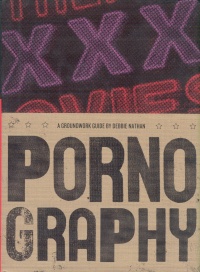| ________________
CM . . . . Volume XVI Number 5. . . .October 2, 2009. 
 |
Pornography. (A Groundwork Guide).
Debbie Nathan.
Toronto, ON: Groundwood/House of Anansi Press, 2007.
144 pp., pbk. & hc., $11.00 (pbk.), $18.95 (hc.).
ISBN 978-0-88899-767-8 (pbk.), ISBN 978-0-88899-766-1 (hc.).
Subject Headings:
Pornography.
Pornography-Social aspects.
Grades 9 and up / Ages 14 and up.
Review by Greg Bak.
****/4
|
| |
|

excerpt:
Very few people know that porn has not been shown to cause mental illness or crime. Even fewer have heard arguments from religious leaders, feminists and mental health professionals that porn is beneficial for many people. It can help adults who grew up ashamed of their bodies and sex. It can provide a substitute for people who feel sexually aroused but don’t have sex partners. Think of prisoners, travelers and singles who are separated from husbands, wives, boyfriends and girlfriends. They can use porn to masturbate or otherwise feel sexually satisfied. This ‘virtual’ approach can be safer – and often kinder, gentler and cheaper – than hitting the streets in search of a casual hook-up.
And there is the undeniable fact that many people simple enjoy porn and feel that they have no problems with it at all.
Debbie Nathan is frank and cool as she surveys arguments against and defenses of a ubiquitous and profitable aspect of our virtual and physical world. Pornography, as she says, is everywhere.
Dislike for porn has been one of the few points on which many feminists and social conservatives have been able to agree. Those who would censor porn because they consider it obscene have found allies in feminists such as Robin Morgan (who famously asserted that “pornography is the theory and rape is the practice”) and Bonnie Klein (the Canadian creator of Not a Love Story, a documentary that is harshly critical of the porn industry). Nathan admits that many arguments against porn seem to “make sense” and can be emotionally compelling, especially when they detail porn practices that are degrading to women or that create the illusion of child abuse (Nathan describes child pornography, itself, as an illegal activity, properly dealt with through law enforcement). It has been frequently argued by pornography’s critics that consumption of porn makes men more likely to disrespect, abuse or rape women and children.
Arguments that are logically or emotionally compelling are not necessarily correct, and Nathan provides summaries of criminology statistics and behavioral studies indicating that the consumption of porn has never been decisively linked to criminal behavior of any type. Rather, evidence suggests that people routinely and without difficulty distinguish between sexual fantasies and lived realities. There are undoubtedly reasons why “barely legal” porn is so popular in the North American market, why interracial porn is disproportionately popular in the American South and why extremely violent porn is quite popular in Japan, but there is no evidence to link any of these trends to crime of any sort. Nathan cites the Japanese example as particularly interesting, since Japanese research has demonstrated a link between declining rates of sexual crimes and increasing availability of porn.
Our own culture, as described by Nathan, is increasingly “pornified.” On the Internet, porn is never more than a few clicks away, but Nathan points out that the “pornicopia” includes booming sales of XXX DVDs, explicit lyrics in pop music, and mainstream success for television shows such as Sex and the City and books such as How to Make Love like a Porn Star, Jenna Jameson’s memoir of her years in the porn industry. Nathan’s focus is, for the most part, on contemporary culture, but she does dip into the history of porn, noting that porn can only exist in a culture that endeavors to suppress human sexuality. Her brief look at explicit sexual representations in ancient Roman culture – found in murals and frescos throughout domestic spaces and on all sorts of food and drink vessels, including those for children – suggests that sexually open cultures may not have a need for porn. Nathan explores the connection between porn and shame, suggesting that, without shame, there can be no porn – porn must make the consumer feel “dirty” to be considered porn – meaning that porn, like beauty, resides in the eye and mind of the beholder. By defining porn in this fashion, Nathan sidesteps the debate over what constitutes pornography versus erotica versus explicit representations of sexuality. Though she does not push the point, Nathan’s discussion of the modern “pornucopia” seems to suggest that our own culture might eventually arrive at a point at which sexual imagery is so ubiquitous that it ceases to be pornography. This, in Nathan’s opinion, would be for the best, for it would leave people free to explore their sexuality without shame, guilt, loneliness or anger.
Nathan’s book is published by House of Anansi Press and Groundwood Books as part of the “Groundwork Guides” series. As with other books in the series, the book is short, written in plain language, controversial and a thoroughly compelling read.
Highly Recommended.
Greg Bak is an archivist with Library and Archives Canada in Gatineau, PQ.

To comment on this title or this review, send mail to
cm@umanitoba.ca.
Copyright © the Manitoba Library Association. Reproduction for personal use is permitted only if this copyright notice is maintained. Any other reproduction is prohibited without permission.
NEXT REVIEW |
TABLE OF CONTENTS FOR THIS ISSUE- October 2, 2009.
AUTHORS |
TITLES |
MEDIA REVIEWS |
PROFILES |
BACK ISSUES |
SEARCH |
CMARCHIVE |
HOME |
